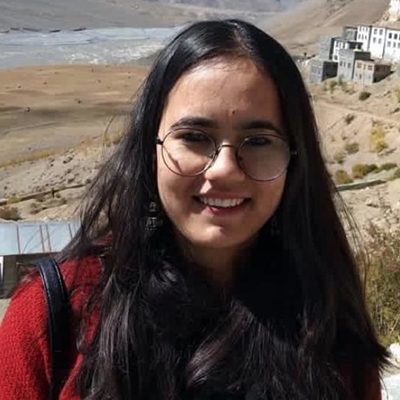When you are 24, and a successful painter at that, brushing off worries comes easy. That’s why Shaiqa Shaukat, who was diagnosed with PCOS (polycystic ovary syndrome) back in 2020, felt that she could take it in her stride with medication and get on with life. Except she couldn’t. One year down the line, in 2021, she was diagnosed with Type 2 diabetes. All because she ignored her doctor’s recommendation to get herself tested for the condition, mistakenly thinking a gynaecological issue could not be so big as to cause a co-morbidity. And because it had been unchecked for a while, she swung between dizzy spells and blackouts. Now, at 27, she has wrested her life back, measuring it in facts and figures. With a glucometer strapped to her body, she feels reined in by discipline but is glad it has given back her familiar rhythms. “I am always counting: How much to eat, how many calories to burn, how many hours to sleep,” says Shaiqa, the metaphor even apparent in her art cafe, The Pint Room, in the busy D block Market, Vasant Vihar, New Delhi. She is now one among many young Indians living with diabetes.
Women with PCOS are often insulin-resistant; their bodies can make insulin but can’t use it effectively, increasing their risk of Type 2 diabetes. Dr Amrita Ghosh, consultant at Fortis CDOC Hospital for Diabetes and Metabolic Disease, says that almost 20 per cent of her patients are less than 25 years of age and are being diagnosed with PCOS-linked Type 2 diabetes. “Everyday I see at least five patients with PCOS and Type 2 diabetes. Both diseases have a common root cause of insulin resistance and obesity. I always tell them to get themselves screened and reduce their weight immediately. Considering that most Indians are risk-prone, given their genetic history and aggravating triggers like dyslipidemia and hypertension, they should go for a simple oral glucose tolerance test, where your blood glucose samples are compared before and after consuming a 75 gm glucose drink. Every young person should get this done,” she adds.
HOW STRESS TRIGGERED HER PCOS
Shaiqa, who came to Delhi from Siwan, Bihar, in 2010, and made a living by doing paintings commissioned by corporates, schools and individuals, had a change of fortunes in 2020. “That was a bad year. The pandemic meant that I lost out on work as an artist. My relationships collapsed, I did a lot of stress-eating and developed insomnia. And one fine morning, I had a sharp, shooting pain in my back that left me moaning and screaming for help. My sister, a trained physiotherapist, sensed something unusual and rushed me to a gynaecologist,” says Shaiqa. She was diagnosed with PCOS, a condition in which the ovaries produce an abnormal amount of androgens, male sex hormones and get covered by numerous small cysts (fluid-filled sacs). As Shaiqa was experiencing extreme stress and anxiety, her PCOS became apparent because of cortisol, a stress hormone, which hastens the secretion of male hormones and raises insulin resistance.
She was put on hormonal pills, multi-vitamins and Metformin for her spiked blood sugar levels. “The doctor suggested that I get a consultation from an endocrinologist as well. I procrastinated for months. That was my undoing as I thought my sugar levels would normalise with drugs,” says Shaiqa.
EARLY ONSET OF DIABETES
By early 2021, she developed severe fatigue, was hardly able to pull herself out of bed, felt dizzy and would often fall unconscious. She had unexplained hunger pangs, sudden weight gain and bouts of depression. So she finally consulted an endocrinologist to understand her body and was diagnosed with severe Type 2 diabetes that demanded a complete overhaul of her lifestyle and preventive protocols as she could not afford to contract any infection. “To compound matters, my partner ended our relationship when he found out that I had diabetes,” adds Shaiqa, who let out her fears and anxieties in her series of grey charcoal sketches. She was prescribed medicines such as Glucobay, Glucreta, multi-vitamins and Vitamin D.
CRAVINGS AND CALORIE CONTROL
Initially, Shaiqa had trouble controlling her craving for sweets and junk food. Then she worked with a nutritionist on her calorie chart without compromising on the familiarity of flavours. “Now I mix oat flour and wheat for my rotis. I eat sauteed chicken, vegetables and have included various kinds of seeds in my diet, such as sesame, flax, chia and basil. I consume low fat cow milk,” Shaiqa tells us. She has stopped consuming butter, coffee, sauces, carbonated drinks and pickles as well and developed a taste for chamomile, hibiscus and green tea. “I eat at regular intervals and avoid long gaps. I keep a count of my calories. On days I exceed the limit by chance, I rectify the balance the very next day,” she adds. Shaiqa never went for fad diets and chose to go with home-cooked meals, achieving desired results with smart arithmetic.
DIABETES AS A LESSON IN LIFESTYLE MANAGEMENT
“Earlier, I had no schedule for my personal life. Now I have a schedule for both my work hours and me-time. I try to sleep by 10-10.30 pm and wake up by 6.30-7 am. This way I can fall asleep naturally and am not wakeful anymore,” says Shaiqa, who also runs a restaurant, which demands that she remain active till late night. However, with support from her staff, she has managed workarounds. She plays badminton on a regular basis and works out at a gym, of course with medical advice. “Diabetes has made me very conscious and I keep myself updated about the condition,” says Shaiqa, who has a glucose monitoring machine attached to her body. She replaces this every 15 days to get a graph of her blood sugar levels. “It is important to monitor this graph. If it goes high, then I know what I need to do over the next 15 days. It is my reality check. Once my sugar levels remained stubborn despite sticking to a regime. I discussed this with my doctor and through a system of elimination, found that my habit of consuming ketchup with everything was pushing up my sugar levels,” says Shaiqa. That’s when she gave up her indulgence for life.
Over the last three years, Shaiqa’s HBA1C (average blood sugar level) count has come down from 7.5 to 6.2, which her doctors say is a significant improvement. While doctors have praised her efforts and shown optimism, she knows her life won’t be a smooth ride. Ever. “It’s like a borrowed life, taking care of it moment to moment, never letting myself slip. Besides, there’s a stigma of diabetes being equated with some kind of sickness. While my family has been supportive, my relatives ask me to hide my condition. But I own my battle scars because diabetes is not a punishment, it has been my life organiser and taught me how to live,” says Shaiqa, summing up the sense of purpose she feels for the first time.
India is growing robustly relative to its peers…there is room to grow further: IMF’s Antoinette Sayeh


 Ankita UpadhyayAnkita Upadhyay is a health reporter with The Indian Express' Delhi bu… read more
Ankita UpadhyayAnkita Upadhyay is a health reporter with The Indian Express' Delhi bu… read more